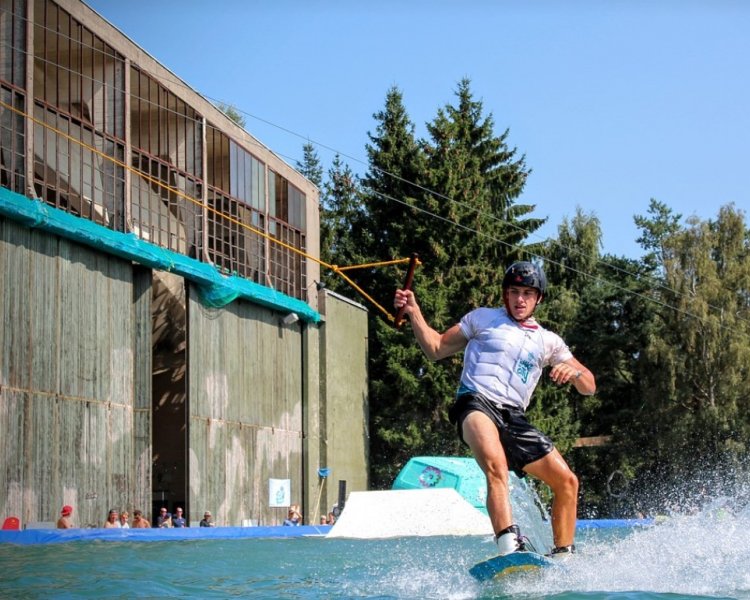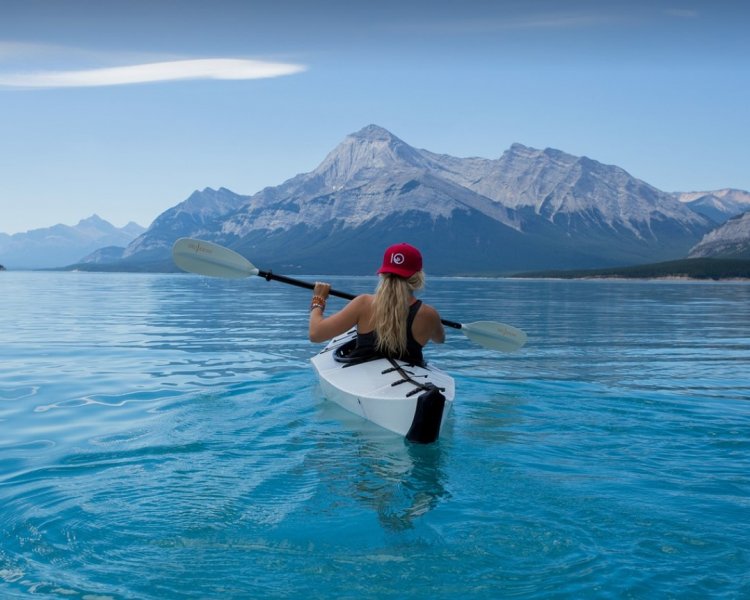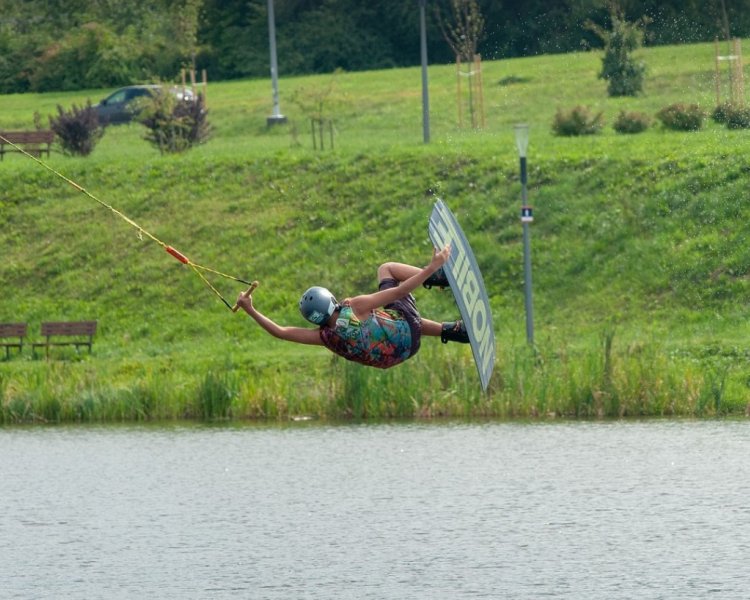Here's What You Need For Wakeboarding! (The Complete List)

Wakeboarding is an exciting sport that involves the wakeboarder riding on his or her board and doing tricks while being pulled by a boat over water.
The sport is both recreational and competitive and requires the wakeboarder to practice safety and precaution in order to prevent accidents.
But what do you need for wakeboarding? There are five things that all wakeboarders need.
- Wetsuit
- Buoyancy Aid
- Helmet
- Wakeboard
- Wakeboard Boots (or Bindings)
All wakeboarders need these five things in order to properly perform tricks and remain safe while doing it.
5 Things That All Wakeboarders Need
It is usually recommended to rent your wakeboarding gear when you are first starting out, so you can make sure that the sport is for you before investing your money.
Once you’ve decided to go all in, though, it is time to make sure you have the proper gear to enjoy your new sporting adventure.
Wetsuit
A wetsuit is usually made with foamed neoprene, a form of synthetic rubber, and is worn by people who perform water sports – like wakeboarding, surfing, and diving.
There are many reasons that a wetsuit is necessary for wakeboarding.
- It provides thermal insulation.
- There are gas bubbles within the suit’s material that allow for buoyancy.
- The suit helps to protect against abrasions.
- It provides a shield from ultraviolet rays.
- It protects from stings from marine organisms.
As you can see, wetsuits are much more than just something to help your body stay dry during wakeboarding. They provide lots of added protection.
Looking for a wetsuit? This review of our top #5 picks might be helpful to find the right one for you.
Buoyancy Aid
Even though the wetsuit provides some added buoyancy, it is still necessary to wear another buoyancy aid while wakeboarding.
Most often wakeboarders choose a life vest, sometimes called a life jacket. This can help a wakeboarder stay afloat when they fall into the water.
Buoyancy aids are very important because some falls during wakeboarding will result in the wakeboarder being knocked out – having hit his or her head on the wakeboard or making an extremely hard impact with the water. In these cases, buoyancy aids help to keep the body afloat until help arrives.
Helmet
Wakeboarding involves traveling at fast speeds and, in competitions, there are usually obstacles that the wakeboarder is meant to travel around.
This is why it is incredibly important to wear a helmet while wakeboarding. You have to be sure to purchase a wakeboarding helmet, though, because regular helmets won’t work.
Wakeboarding helmets are lightweight, water resistant, and ventilated.
This makes the helmet suitable for the sport because it is lightweight enough that it will not weigh down your head, it is resistant to water, so it doesn’t become saturated, and it is ventilated to allow water to flow out of the helmet.
#Our pick
Retrospec CM-1 Classic Commuter Multi-Sport Helmet with 10 Vents
Main features

- Interchangeable pads
- High quality EPS foam
- Great ventilation
- Different customized designs
- Versatile -can be used in many sports-
- Reasonable price
The thing that we like the most about this model is its versatility. We have tried it both for skateboarding and wakeboarding and it felt really comfortable. On top of that, we love the classic design and the possibility of customize it. Great choice for a helmet!
Wakeboard
A wakeboard is rather important to have when it comes to wakeboarding because, well, it’s the board the wakeboarder rides on!
There are many different styles and brands of wakeboards for you to choose from. It’s truly up to your preference and what works best for you.
Additionally, you have to consider if you are doing this for recreation or competition.
Competition usually requires that a wakeboard be designed to perform tricks and dodge obstacles, so you may want to opt for a higher-quality wakeboard if you are planning to compete.
Wakeboard Boots (or Bindings)
Wakeboard boots are crucial for wakeboarding because they are what attach your body to your wakeboard. There are various types and styles to choose from.
The main factors to consider when you are choosing your bindings are:
- Do they fit my feet?
- Do they attach properly to my wakeboard?
- Are they comfortable?
Everything You Need to Know About Wetsuits
The modern wetsuit was invented by physicist Hugh Bradner in 1952. Wetsuits became popular in the mid-1950s, and there were many improvements made to the wetsuit over the next few years, such as the neoprene going from being unprotected and fragile to being sandwiched between layers of spandex.
There are many variants of the wetsuit:
- The Sleeveless Vest – This covers only the torso. Sometimes it includes hoods and is referred to as a hooded tunic.
- The Jacket – This covers the torso and arms but doesn’t cover much of the legs. Some may have short legs or resemble a woman’s swimsuit with leg holes.
- The Beavertail – This is a bodysuit style that has a flap that passes between the legs and attaches to the front.
- The Spring Suit – This style covers the torso completely and has short legs with either short or long sleeves.
- The Trousers – These wetsuit pants just cover the lower torso and legs.
- The Short John – This style is also called a shorty, and it covers the torso and extends to the knee. It does not have sleeves.
- The Long John – This style has many nicknames – johnny, johnny suit, and farmer john or jane. It covers the torso and all of the legs and resembles a bib overall.
- The Full Suit – Also called a steamer, this wetsuit covers the entire torso, all of the arms, and all of the legs. There are some short-sleeved versions with full legs as well.
The thickness of your wetsuit will depend on the activity you are planning to do and the temperature of the water you will be in.
For wakeboarding, you will need to make sure that you have enough flexibility to move while also being able to stay warm.
The suggestions for wakeboarding wetsuit thickness according to temperature are:
| Temperature | Thickness/Type of Wetsuit |
| 40 degrees + | 6/5/4 sealed |
| 48 degrees + | 5/4/3 sealed |
| 52 degrees + | 4/3 sealed & taped |
| 58 degrees + | 4/3 sealed |
| 60 degrees + | 3/2 sealed |
| 65 degrees + | 3/2 flatlock |
| 72 degrees + | Springsuit, Neoprene Top, Poly Top |
| 80 degrees + | Poly Top, Rash Guard |
For maximum flexibility, wakeboarders tend to prefer neoprene suits that are 60% to 100% stretch in order to all for the best fit and flexibility.
Terms you should know when it comes to wakeboarding wetsuit seams are flatlock, sealed, and sealed & taped.
- Flatlock seams are made for warmer temperatures, typically over 62 degrees. They resemble railroad tracks and have a flat interior. It is possible for some water to enter the suit through this seam.
- Sealed seams, which are glued and blind stitched, are good for any water that is 55 degrees or higher. These seams are glued together first, and then they are stitched together. This type of seam doesn’t allow much, if any, water into the suit.
- Sealed & Taped seams, which are glued, blind stitched, then 100% taped, are the seams that are made for very cold water (under 55 degrees). These are made just like the sealed seams; then, the seams are taped on both the interior and exterior. These seams prevent all water from getting in.
Wetsuits can feature many different zippers; they can have front zippers, cross shoulder zippers, cross chest zippers, and vertical back zippers. It’s important to choose a suit that has zippers you can easily work.
Additionally, you should make sure that the suit fits properly. If your suit is too tight, it can cause difficulty breathing or acute cardiac failure. If your suit is too loose, it won’t insulate your body, and it will allow water in. You can purchase standard sized suits, or you can order custom fitted suits.
Looking for a wetsuit? Check out this review of our top #5 picks for some inspiration.
Everything You Need to Know About Buoyancy Aids
A buoyancy aid is just a fancy name for a personal flotation device or PFD. Another word commonly used to refer to PFDs is life vest or life jacket.
Generally, there are three different fits of buoyancy aids:
- Over the Head Vest – This life vest is a single piece that is pulled over the head.
- Front Zip Jacket – This buoyancy aid has a zipper down the front and is worn like a regular jacket. One drawback to this style is that it lessens the front buoyancy because the flotation foam is split into two parts for the zipper to extend down the middle.
- Side Zip Jacket – This jacket combines the other two types, putting its zipper completely down one side to make sure that the flotation foam is evenly distributed throughout the front and back. It is also much easier to put on because of the side zip design.
When choosing your PFD for wakeboarding, it’s important to consider three factors – chest size, weight, and how much buoyancy is needed.
These three factors determine what size and type of buoyancy aid you will need.
Everything You Need to Know About Wakeboarding Helmets
Because of the potential danger of wakeboarding, it’s crucial to have a proper wakeboarding helmet. When choosing a wakeboarding helmet, you have to consider fit, safety, drainage, and lining.
- Fit is important because you do not want your helmet to slide off while you are wakeboarding. To find the right fit, measure the circumference of your head and compare it to the size charts of the different helmet brands.
- Safety is necessary. Your helmet must be able to protect your head in the event of an accident. Make sure that the helmet you choose is certified by the WRSI or CEN.
- Helmet drainage is key. Your helmet will take in lots of water. It needs to be able to properly drain the water out, so the helmet does not soak it up.
- Proper helmet lining is another vital part of a good wakeboarding helmet. You want to find a helmet that has waterproof EVA lining and a padded inside, so you will have a comfortable helmet fit with water resistance.
Everything You Need to Know About Wakeboards
Choosing your wakeboard is completely up to personal preference. There are different types of boards made for various activities, but you want to purchase the one that is right for you.
Boat Boards
Boat boards are made for wakeboarders that typically ride behind boats. Boat boards tend to be stiffer than other boards, giving them the ability to ride over waves created by the boat. They are more durable than other boards so they can handle more wear and tear.
Boat boards have specific features added to their bases that allow for softer landings and have fins that are attached to the board for help with steering.
Wake Park Boards
Some boards are made for riding at wake parks. These are referred to as wake park boards, and they are made to be softer than boat boards and have no features on their bases.
Additionally, these boards either don’t have fins, or they have removable fins.
Because of the absence of these features, wake park boards don’t have much traction on the water. They are made to absorb landings and not get hung up on obstacles and rails.
Hybrid Boards
For people who want to only purchase one board to ride behind boats and enjoy wake parks, you will want to get a hybrid board.
Hybrid boards are made to be a mix of boat boards and wake park boards, providing durable and simple bases with removable fins.
10 Tips to Help You Choose a Wakeboard
Once you know the basic types of wakeboards that you can buy, it’s time to focus on which one is right for you.
Here are ten tips to help you with your choice:
- Make sure to purchase your own board. This doesn’t sound like a tip, but sharing or renting boards doesn’t allow you to truly bond with and get used to your board.
- Check the labels of the board before you purchase it. Wakeboards tend to come in three skill levels – beginner, intermediate, and advanced. Beginner boards allow for more of a learning curve, and advanced boards are suitable for people who know how to handle a wakeboard well.
- Make sure the size is right. You have to consider your weight and height when choosing a board because it needs to be able to properly support your entire body.
- Check to see what the board is made of. Some boards have foam cores, and others have wooden cores. There are even some boards that are made with graphite. Each type of core fits different wakeboarding needs.
- Make sure the board is your style. There are single tip and twin tip boards for different riding styles. How you ride on your board will determine which one you should choose.
- Determine the rocker that you want. There are two basic rocker categories – continuous and three-stage. The type of rocker that you choose affects how you can land jumps and tricks.
- Figure out your fin preference. Fins can be bolted or molded onto the board, and they can also be removable. Sometimes you may need to try out a few fin styles to find your preference.
- Make sure the shape is right for you. Beginner boards have edges that are squared off to help with control, and advanced boards have rounded edges that allow for more tricks and turns.
- Don’t compromise on your boots/bindings. Finding bindings that fit comfortably and securely on your board is vital for safety. Beginners can purchase bindings that are adjustable to use while they get used to wakeboarding. Custom bindings can be purchased later.
- Try out different boards before you purchase. Knowing what your preferences are before settling on your board is crucial. This is the only way to really know what fits your needs and wants.
Everything You Need to Know About Wakeboard Boots (or Bindings)
Bindings are important for balance, control, and safety. You have to make sure that you find boots that fit your feet perfectly and comfortably.
There are a few features of wakeboard bindings that you need to consider when buying yours.
Flex
Flex is the term used to refer to the flexibility of your bindings. Some wakeboarders prefer to use stiff bindings while others choose more flexible bindings to allow for more movement.
For beginners, it is recommended to use more flexible bindings as you get used to the sport.
Stiffness of bindings is measured on a 1 to 5 scale with 1 being the softness and 5 being the stiffest. So, when you are choosing your bindings, make sure to look at what they measure on the stiffness scale.
Fit and Features
The fit of your wakeboarding boots is crucial. They cannot be loose. Make sure to purchase bindings that are snug and form-fitting – but not tight enough to be painful.
There is a large range of sizes for bindings, so you should definitely be able to find your correct size.
Some bindings have heat moldable liners that conform to your feet to improve fit. Some wakeboarders have to use boot lubricant to get their feet into their snug boots.
Available types of bindings include open-toe, closed-toe, and system bindings. They use fasteners, the BOA lacing system, or Velcro straps to fasten.
Board Compatibility
Your bindings have to be compatible with your chosen wakeboard. This is necessary for proper fit. Some brands of bindings are not compatible with certain brands of wakeboards.
Make sure that your bindings and wakeboard are able to work together correctly before making your purchase.
Know the Wakeboarding Hand Signals
Since there are lots of noises and distance involved in wakeboarding, there are hand signals that have been developed in order to communicate information when you may not be able to hear the wakeboarder.
Important signals that you must learn are:
- Speed up – thumbs-up
- Slow Down – thumbs-down
- Okay – thumb and pointer touching each other to make a circle with the other three fingers extended
- Turn – one finger pointed into the air and moved in a circular motion
- Back to the Dock – pat on the head
- Cut Motor/Stop – a slashing motion across the neck with one finger
- I’m Okay – both hands clasped together over the head
These signals are simple and easy to learn, but they are vital for communication between wakeboarders and boat drivers.
Tips for Proper Wakeboarding
Getting the proper gear and equipment for wakeboarding is number one on the wakeboarding to-do list and knowing how to handle yourself on your wakeboard comes next.
Some tips for wakeboarding include:
- Always wear a life vest. Always.
- When you are riding your wakeboard behind a boat, have a spotter assigned to sit at the back of the boat to be able to tell the driver your position and look out for objects that may pose a threat to you.
- The best foot to put in the front of your wakeboard is the foot you always tend to put forward first.
- Don’t try advanced stances if you are a beginner. Beginners should try a basic stance that places the boarder’s weight on the back of the wakeboard.
- Lengthen your rope as you become more comfortable on your wakeboard.
- Until you get out into the water, stay crouched down low and close to your board. You can slowly stand once you are in the water.
- Make sure to distribute your weight correctly. About 60% of your weight should be on your front foot when you are in the process of standing up, but when you are standing the majority of the weight should be on the back of the board.
- Hold your tow handle low and parallel to the water to increase your chances of being able to stand up.
- If you’re riding behind a boat, the maximum speed is about 19 miles per hour. Wakeboarding doesn’t require near as much speed as other sports.
- Most importantly, take your time and learn your gear and your sport. You will make plenty of mistakes, and you will learn from them.
In Conclusion
To be completely set up for wakeboarding, you need a wetsuit, a flotation device, a helmet, a wakeboard, and bindings.
Additionally, you should memorize the hand signals and look into what it takes to be safe while wakeboarding to make sure that you lessen your chances of accidents.
Wakeboarding is an exceptionally fun sport, but it takes much discipline and practice to be able to become a great wakeboarder.
Follow this guide, and you’ll be ready for wakeboarding competition in no time!
...



